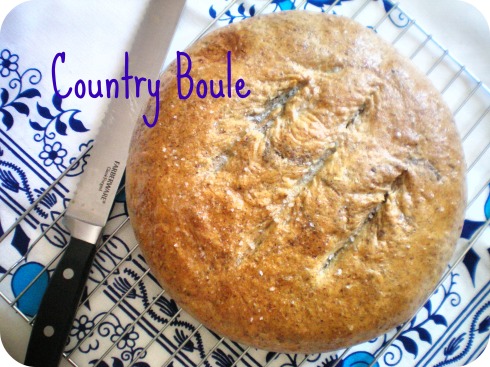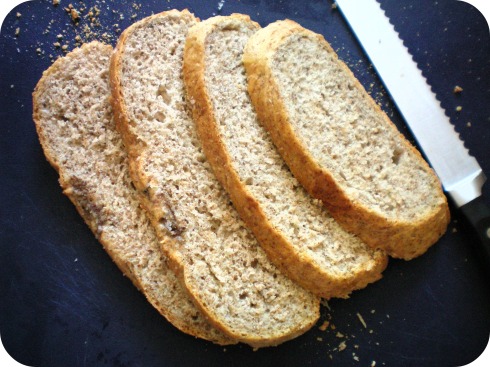You are currently browsing the tag archive for the ‘bread baking’ tag.

Recently I have taken up a perilous hobby, one that leaves my heart palpitating with fear, a constant sweat on my brow. My hobby requires consummate skill and know-how; one misstep can mean disaster. No, I’m not talking about race car driving or jumping out of planes with a parachute. My new hobby is bread making.
It all starts with yeast. For as long as I have been interested in the goings-on of the kitchen, I have been afraid of yeast. Okay, perhaps afraid is too strong a word, but certainly intimidated. Yeast is what causes breads to rise and makes delights such as pizza and brioche possible. But its fickle and mysterious powers can lead to disappointment if you don’t know exactly what you are doing. It has led me to be the creator of more than a few leaden loaves of bread, of cinnamon rolls that resembled hockey pucks. I can tell you that for a long time, I gave up on yeast.
When it comes to bread, yeast is just the beginning. If you’ve ever tried to make your own, then you know that there are other crucial factors, such as the type of flour you use (protein is a big issue, I have discovered), the temperature of the room where you give rise, the ratio of the ingredients you use. Things can go wrong–and they often do–which is why I had once largely avoided bread making.
Yet every time I went to the bakery I was enraptured by the heavenly smell of bread baking in the oven. I wanted that smell in my own house. As much as I loved taking a fresh, crusty loaf home and eating it with my lunch, I wanted to pull my own bread out of the oven, to break off a chunk of it and slather it with sweet butter while it was still hot. What in life is as pure, as elemental?
On my crusade for the perfect loaf I consulted many books. Every one of them, I felt, made things more complicated than they had to be. I’m the type of person that wants to know why I’m doing something when I do it. Why do you have to punch dough down? Why do some breads need two, three risings and others just one? How do you really know when to stop kneading? Why knead at all? I wanted something simple, a dough I could quickly mix together and forget about until it was time to put it in the oven. At one point, I thought that the No knead bread published in the New York Times, the one that took the blogging world by storm a couple of years ago, was going to be the answer. The problem was that I didn’t have a Dutch Oven and I wasn’t about to go out and buy one. One-hundred-and-fifty dollars can get you a lot of bread.
So I did what I should have done a long time ago. I turned to Grandma.
My grandmother has been baking bread since she was old enough to see over the kitchen counter top. I have never known her to eat bread from a bag or buy a loaf from the bakery. Back in Serbia, where she spent the first half of her life, bread baking was a daily affair. I thought she might have some wisdom to impart to me. I was right.
This recipe is even simpler than I could have dreamed. You don’t need a scale, you hardly have to knead the dough at all, and you can plunk it right into the pan for its second rise. The work is minimal, really. You just need to pick a day when you are home for a few hours. The result will be delicious and ultimately satisfying.
Now, it’s not one of those really rustic loaves–the kind with the bubbly interior and a crust that saws into the roof of your mouth when you bite into it. We leave that to the baguette. This bread has a delicate yet chewy crust, with a soft and mealy interior, perfect for slathering with butter. It’s the kind of bread you want to mop your plate with, hearty yet light, great for sandwiches and lovely as toast. Try this recipe; it just might make you into a bread baking convert.
Note: You will notice that I use live yeast in this recipe because I think it gives the best flavor, however you can use one package of regular dried yeast if you wish.
Grandma’s Country Boule

Ingredients:
2 ounces fresh yeast
2 cups water
1/2 teaspoon sugar
2 cups all-purpose whole wheat flour
2 cups all-purpose white flour
1/2 cup ground flax seeds
1 teaspoon salt
olive oil
Directions:
1) In a large mixing bowl, dissolve the yeast in 1 cup warm water. Add sugar. Mix together with a whisk.
2) Sift the white flour and add to the mixture. Add whole wheat flour, flax, and salt.
3) Mix in 1 cup of water with a wooden spoon until a dough forms. Coat hands with a bit of oilve oil and mix, scraping the bowl. If the dough is too sticky, sprinkle with additional flour.
4) Knead until combined, not too soft or tough. This will really only take a minute or so. Cover the bowl with a cushion and leave to rise for one hour. Preheat oven to 375F.
5) After one hour, oil hands again and punch the dough down. Knead on oiled board or countertop for a few seconds. Shape dough to a greased 9 or 10-inch springform pan. Allow to rise another three-quarters of an hour, covered with a tea towel.
6) Wet hands with cold water and smooth over the top of the dough. Make three slits or a checkerboard pattern on top with a sharp knife. Bake for about 45 minutes, or until the bread is golden brown.
7) Allow to cool on a rack for five minutes, then brush the top with butter. Sprinkle with coarse sea salt or wheat bran, if desired.
















